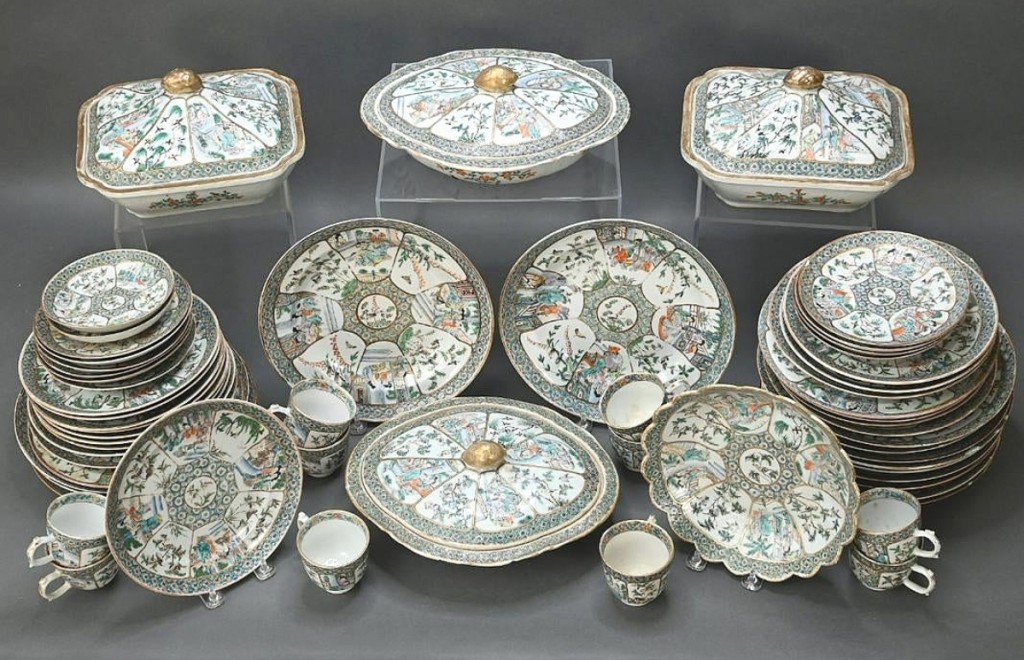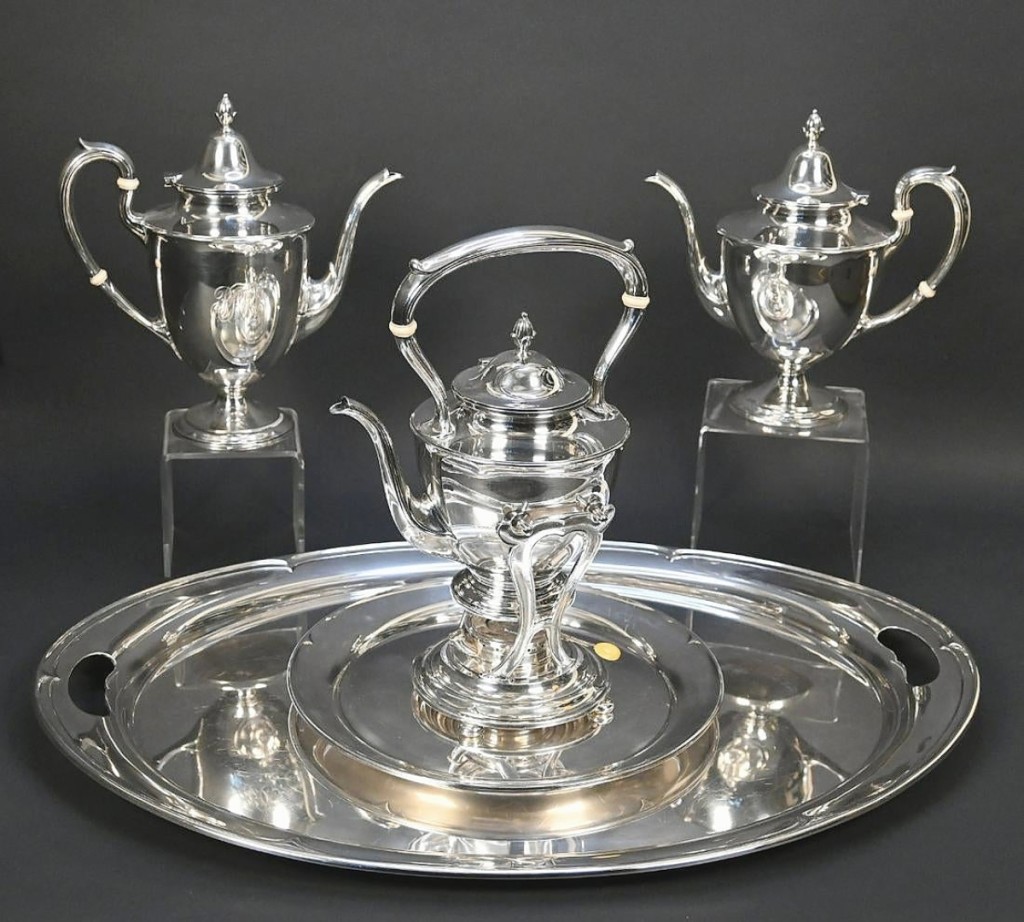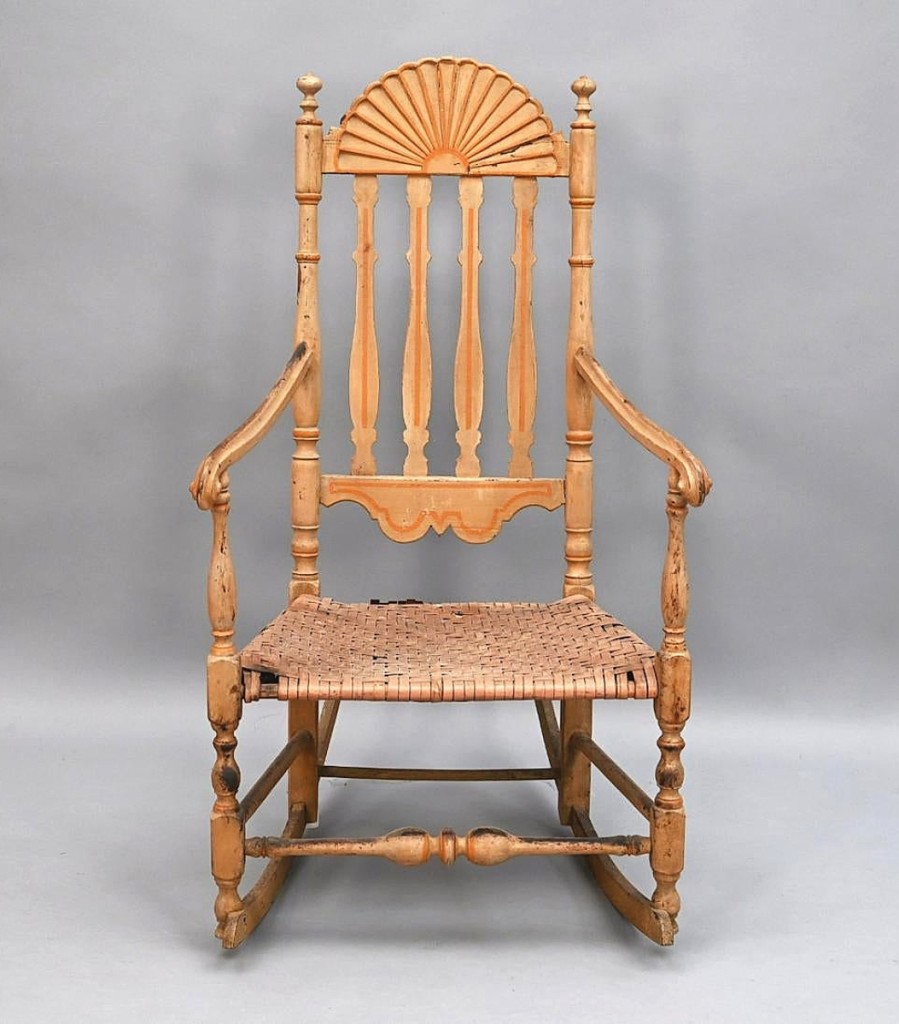
This partial famille verte dinner service included 67 pieces, including two pairs of covered vegetable dishes. Sold as one lot, it realized $5,100.
Review and Onsite Photos by Rick Russack
EPPING, N.H. – Devin Moisan has been in the auction business for more than 25 years and never utilized the internet for bidding – until December 4. He had been conducting several sales a year and was a firm believer that live, in-person auctions were the way to conduct business. Better for the buyer, better for the consignor and better for the auction house. For this sale he utilized two online bidding platforms. Not only was it a new way of doing business for him, it was also the first sale he conducted in his spacious, new, well-lit gallery with numerous showcases to display smalls and plenty of room for furniture. Most of his material has always been fresh from homes and estates in southeastern New Hampshire and continues to be, although his reach is widening now.
A few days prior to the sale, Moisan said, “It became obvious that in order for the business to survive, we had to embrace the internet. I spoke to several of my friends in the business, and they unanimously said it was the way to go. They all said it’s a lot more work, both before and after the sale, but it would be worth it. Catalog descriptions have to be comprehensive and numerous photos would be needed. We uploaded more than 2,600 pictures. In the past, buyers would come to the sale, examine the lots that were of interest and make their decisions. Our reach now is much wider, and many interested buyers can’t get to our preview. So we get numerous requests for more photos and more information on condition. That’s fine. Because of Covid considerations, we had to schedule previews and we used an online platform to do the scheduling. The preview was a full week and we had about 125 people come in. That’s good. I know the internet will help in bringing in consignments. In the past, some of the potential consignors I spoke to told me they had decided to go with another auctioneer because they offered internet bidding, so I lost out on some stuff I would have liked to have sold. So, while I was reluctant, I now understand the ability to bid from home is what buyers expect. And it will improve my business.”
Another benefit of the online-only format became obvious the day of the sale. The weather forecast correctly predicted a stormy day, with power outages possible and difficult driving conditions. It was a forecast that in the past might have had made an auctioneer think about postponing a sale. The need to be concerned about weather the day of the sale is now greatly reduced – a significant plus for New England auctioneers.

There was a strong selection of quality silver in the sale. This Gorham sterling partial tea/coffee service in the Dolly Madison pattern included the teapot, the coffee pot, a kettle on stand and two trays. The total weight was 254 troy ounces and it sold for $5,100.
The sale included historical New Hampshire documents, early furniture, silver, blue Staffordshire, early glass, Chinese export porcelains, several paintings, trade signs, clocks, French cameo glass and more. It started off with paper of New Hampshire interest. The group included documents signed by John Wentworth, New Hampshire’s last royal governor, whose marriage to longtime love, Frances, just three weeks after her husband’s death, created a local scandal. The document offered was a maritime passage signed in 1772, just a few years before the couple was forced to flee Portsmouth when revolutionaries pointed a cannon at their front door. It sold for $1,080. (Frances later took a lover in the son of King George III.) Also doing well from this group was a highly detailed 1807 map of the town of Exeter, showing school districts and much more. It was a version of Phineas Merrill’s 1802 map of the town. Although in need of conservation, the map sold for $1,020.
Two of the top ten grossing lots in the sale were silver. Leading the day, finishing at $5,100, was a Gorham sterling partial tea/coffee service. In the Dolly Madison pattern, the lot included the teapot, the coffee pot, a kettle on stand and two trays. The total weight was 254 troy ounces. A five-piece sterling tea and coffee service in the Pointed Antique pattern by Reed and Barton reached $3,480. Included was a sterling tray more than 25 inches wide, and the total weight of the lot was 176 troy ounces.
The sale included several pieces of early glass, some sold in lots, with one goblet that wound up in the top ten. It was a clear glass, Eighteenth Century free blown and engraved goblet, which surprised all, selling for $3,120, well over the estimate. It depicted ledgers surmounted by a rooster, a caduceus and a treasure chest engraved “Credit Balance” and “Het Welvaren Van De Negotii” (The Prosperity Of The Negotti). The goblet probably has an interesting story to tell. Some of the early glass was sold in lots, also exceeding estimates. Six Georgian twisted stem wine glasses with white and cranberry twists, along with five opaque twisted stem wines, earned $1,440. A group of ten clear Georgian ale glasses, together with 16 other early drinking glasses, seemed like a good buy, bringing $1,560. French cameo glass also exceeded expectations. A Daum Nancy footed pillow vase with carved foliage in shades of green brought $3,240, and a 10-inch Galle bowl with colorful, carved autumn leaves, brought $1,320.

It was expected to bring one of the highest prices of the selection of early furniture, and it did not disappoint. The Portsmouth, N.H., William and Mary banister back armchair with a large sunburst crest earned $4,200. The rockers, as well as the current finish, were later additions to the chair.
Several pieces of early furniture crossed the block. Leading the way, at $4,200, even though rockers and later paint had been added, was a Portsmouth William and Mary banister back armchair with a large sunburst crest, block and turned legs, bulbous stretcher and arms that terminated in rams heads. A Massachusetts Sheraton inlaid serpentine front card table on delicate reeded legs went out for $3,600. When asked which was his favorite item in the sale, Devin Moisan indicated a Nineteenth Century pine settle with a scalloped cornice, which realized $1,920.
Someone really liked circa 1820 blue Staffordshire in the Piping Boy pattern. One lot with seven platters in varying sizes up to 17 inches earned $1,800, and a lot with 29 dinner plates earned $1,680. Twenty soup bowls in the same pattern sold for $1,020. The ceramics offerings included numerous examples of Chinese export porcelains. The most sought-after piece was a 9¼-inch-square bowl decorated with a three-masted sailing ship flying two American flags. It achieved $2,640, more than ten times its estimate. A pair of armorial soup bowls brought $720 and a 67-piece partial famille verte dinner service brought $5,100. The set included two pairs of covered vegetable dishes. A highly detailed Rose Medallion 31-inch floor vase reached $1,200. It was decorated with alternating panels of figures and panels with exotic birds and flowers.
After the sale, Moisan said that he was pleased with his first online endeavor. “It was a learning experience for us, but it was worth it,” he said. “We grossed a little over $265,000, but what was most noticeable to me was the number of new bidders, people we’d never done business with before. I spoke to a guy in Kansas about an Oriental rug. He asked me how long we’d been in business and I told him more than 25 years. He said to me ‘How come I’ve never heard about you.’ That’s what the internet does for us. We had hundreds more buyers watching the sale on the two platforms than we could ever have live in a gallery and we sent out invoices to more than 325 buyers, also more than we might have after a ‘live’ sale. So if you’re asking me if I think this way of selling is good for us, my simple answer is yes.”
Prices given include the buyer’s premium as stated by the auction house. Moisan’s next sale will be in February and will utilize internet bidding, in addition to the usual ways.
For information, 603-395-0022 or www.moisan-inc.com.





























